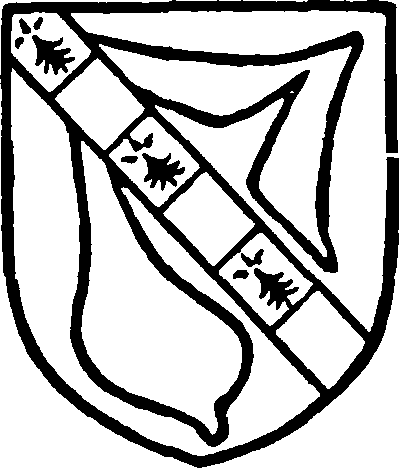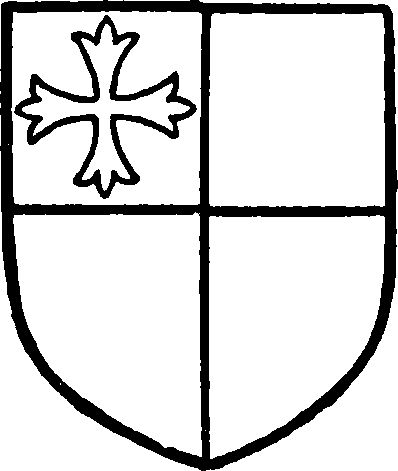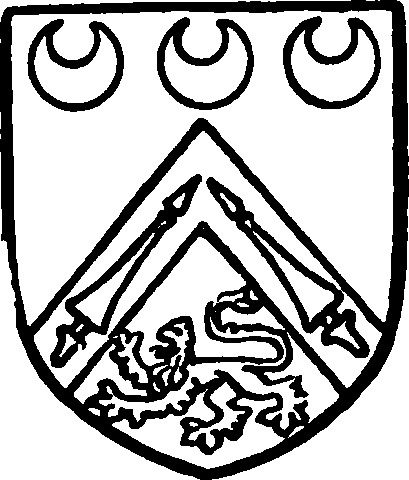Pages 340-343
A History of the County of York North Riding: Volume 2. Originally published by Victoria County History, London, 1923.
This free content was digitised by double rekeying. All rights reserved.
In this section
EASINGTON
Esingetun (xi-xii cent.); Esintun (xii cent.).
The parish comprises the township of Easington with the hamlets of Boulby on the coast at the north and of Scaling to the south; all three places were assessed as one township in 1301–2. (fn. 1) The area is 3,764 acres, of which 149 are foreshore, (fn. 2) 997 are arable land, 1,452 permanent grass, and 447 woods and plantations. (fn. 3) The chief crops raised are wheat, barley, beans and oats. The subsoil is inferior Oolite, with Upper and Middle Lias by the coast, the soil clay and gravel. The Boulby alum mines, which belonged to the lord of Easington in 1689, (fn. 4) were still worked in 1831, when a decrease of thirty in the population was attributed to the low wages paid to the workmen and consequent emigration. (fn. 5) The number of men employed at that time was thirtyseven. (fn. 6) Alum is no longer worked.
Easington, which has a station called Grinkle on the Whitby and Saltburn branch of the North Eastern railway, is very near the flourishing town of Loftus, on the road from Loftus by way of Boulby and Staithes to Hinderwell. This road forms the village street. By Easington Hall Farm, at the eastern end of the village, the moat of the old manorhouse is still to be traced. (fn. 7) At the west end of the village, on the slope of a hill, is the church of All Saints and below it is Town End Cottage. Grinkle Park, (fn. 8) to the south, the residence of Lady Palmer, is situated in a park of 200 acres. Greenhowe Wood adjoins the present Grinkle Wood, and both are skirted by Greenhowe Beck, which comes from Scaling Mill. The height varies from 200 ft. at this point to 700 ft. on the moors in the south.
Boulby and Boulby Grange lie on the cliffs. These, the highest cliffs on the English and Scottish coasts, rising 660 ft. above the ordnance datum, are ever being worn away by the stormy seas. Professor Henry Morley agreed with Haigh in identifying Boulby cliffs with the burial-place of Beowulf, (fn. 9) who, after slaying the monster Grendal, was killed in a fight with a snake and with his dying breath bade the warriors bury him 'after the bale-fire, at the sea's nose,' on 'Whaleness,' which was then to be called Beowulf's Howe. (fn. 10) Professor Saintsbury entirely discredits the identification. (fn. 11) Boulby Grange probably belonged to Whitby Abbey, which had rents in Boulby at the time of the Dissolution. (fn. 12)
Old Boulby and the site of Boulby Hall are threequarters of a mile inland; a spring at this point is known as the Three Crosses Well. West of Boulby the coast line runs due east and west. Rockcliff rises to 700 ft. above the ordnance datum and marks the site of Roudeclif (Raclyve, xiii cent.), a dependency of the manor of Loftus (q.v.) in 1086. There used to be a beacon here. (fn. 13)
The water-mill of Easington is mentioned in 1627. (fn. 14) Of the five mills in the parish belonging to the manor of Easington in 1710, (fn. 15) only two, those of Liverton and Scaling, remain. The names Gibgarth, Sparkcloses, the Wigg House, Rowsgate Holmes, Thornehouse in Dale and Rayes Farm occur in 1651. (fn. 16)
There are public elementary schools at Easington (erected in 1868 by Sir Charles Mark Palmer) and Scaling (built in 1901). Scaling has a Wesleyan chapel.
Manor
Both EASINGTON and BOULBY, composed of 8 and 2 carucates of land respectively, (fn. 17) were in 1086 soke of the manor of Loftus (q.v.), which was held by Hugh Earl of Chester. A knight's fee 'in Easington and elsewhere' was said in 1272 to be held of the constable of Chester, (fn. 18) but this overlordship is never afterwards mentioned. (fn. 19)
These places were not among the lands known to have been given by Henry I to Robert de Brus, (fn. 20) but the under-tenant in the middle of the 12th century called Adam de Brus his lord. (fn. 21) Peter de Brus was mesne lord in 1272, (fn. 22) and Easington and Boulby were afterwards held of the successors of the Bruses as of Kilton Castle (fn. 23) and Skelton Castle respectively. (fn. 24)
The family of Rosel were under-tenants in the 12th century. Sir Walter de Rosel, kt., granted tenements in Easington to the leper hospital connected with Whitby Abbey, and Roger his son confirmed his donation. (fn. 25) Roger de Rosel had mortgaged Easington to Aaron the Jew of Lincoln in 1192 (fn. 26) and owed the king 60s. for Easington in 1194. (fn. 27) The families of Maucovenant and Chamber (de Camera, de la Chaumber, sometimes called 'de Easington' (fn. 28) ), who succeeded the Rosels, seem to have got their lands through co-heirs. Easington and Boulby belonged to Geoffrey [Barde] in 1179–80, (fn. 29) but in 1208 Geoffrey Maucovenant and Beatrice his wife, and Walter Chamber and Hawise his wife, for themselves and the heirs of Beatrice and Hawise, granted tenements in Easington to Robert de Lascelles and Emma his wife and her heirs; at the same time Roger, Stephen and Reginald Rosel put in their claim to these lands. (fn. 30) Geoffrey was succeeded by a son Geoffrey whose son Robert Maucovenant was joint tenant in 1268. (fn. 31) Geoffrey Maucovenant, son of Robert, and Ambrose Chamber held the knight's fee 'in Easington and elsewhere' of Chester Castle in 1272. (fn. 32) A Geoffrey Maucovenant was joint tenant until 1316, (fn. 33) and was called a knight in 1319, after his decease, when his widow Margaret founded a chantry. (fn. 34) In 1428 John Peach and William Coupere held the half knight's fee in Boulby 'cum Glaphowe' (Clarpowe) which Geoffrey Maucovenant 'formerly' held. (fn. 35) Ambrose Chamber had by 1284–5 been succeeded by Gilbert Chamber. (fn. 36) Walter Chamber was assessed for the subsidy in 1301–2. (fn. 37) Ambrose Chamber held half a knight's fee here in 1303, (fn. 38) was joint lord in 1316, (fn. 39) was assessed for the subsidy in 1327, (fn. 40) and held half the knight's fee in 1348. (fn. 41) Roger Peche or Peach is said to have given the manor in the reign of Henry V to his son John on his marriage with Alice daughter and heir of John Bentley. (fn. 42) In 1428 John Peach, William de Cottom and Robert de Easington held separately in Easington the half knight's fee that Ambrose Chamber formerly held. (fn. 43) Margaret daughter of John and Alice Peach married a Cottom, and the manor descended to their son Ralph, then to his son William and his son George Cottom, (fn. 44) who died seised of the manor in 1502, leaving a son and heir William. (fn. 45) William sold the manor to Gregory Conyers in 1527, (fn. 46) but in 1533 Hugh Cottom, kinsman and heir of William, sued Gregory Conyers for the manor, which Gregory surrendered. The suit was possibly collusive as in 1573–4 John Eyre of Bromham, Wilts., brought a suit against Nicholas Conyers, then lord of the manor, and stated that John Bentley of Winterbourne Stoke, Wilts., died seised of the manor in about 1430, and was succeeded by his daughters and heirs Katharine wife of Robert Eyre and Alice wife of John Peach. By an agreement made in 1431 John and Alice Peach and the heirs of Alice were to hold the manor of Easington, but to pay 20s. yearly in St. Mary's Church, Oxford, to the heirs and their descendants. In the time of Robert and Katharine and their son Robert the rent was rendered, but the payment ceased in the time of Robert's son William (the plaintiff's father), when George Conyers was lord of Easington. Nicholas Conyers replied that his grandfather Gregory Conyers of Whitby had bought the manor free of all encumbrances from one Cottom in or about 1520, and denied the descent pleaded by Eyre. (fn. 47)

Conyers of Boulby. Azure a sleeve or with a bend gobony ermine and gules over all.
Gregory Conyers, son of Thomas Conyers, bailiff of the liberty of Whitby Strand, (fn. 48) died in 1540, mentioning in his will rents due to him in Easington lordship. (fn. 49) His son George (fn. 50) died seised of the manor in 1570, but had his capital messuage at Boulby, (fn. 51) and this branch of the Conyers family is henceforth described as 'of Boulby.' His son and heir Nicholas (fn. 52) died in 1635, leaving a son and heir Robert, (fn. 53) who died in or about 1639, and was succeeded by his son Nicholas. (fn. 54) Nicholas in 1666 (fn. 55) had four sons, Nicholas, William, Robert and Ralph, who all died unmarried, (fn. 56) and two daughters, Mary and Katharine. On the death of Nicholas the father in 1686 (fn. 57) his son Nicholas (fn. 58) succeeded, but the manor seems to have been settled on his sister and heir of the whole blood Katharine, who married Richard Myddleton (or Middleton) of Offerton, Durham. (fn. 59) Nicholas, William and Ralph joined in a settlement of 'the manors of Easington and Boulby' in 1688, (fn. 60) and Richard Myddleton, Katharine his wife, and Anne Conyers, widow, were parties to a settlement in 1710. (fn. 61) Francis, eldest surviving son of Richard and Katharine, died in 1763; his sister Katharine married Cuthbert Heron and had a son Thomas, who in January 1749–50 succeeded his cousin Sir Charles Heron of Chipchase, Northumberland, as sixth baronet, (fn. 62) and in 1763 his uncle Francis Myddleton in his Durham estates. He then took the name of Myddleton. (fn. 63) On his death in 1801 without male issue (fn. 64) Boulby, with his other entailed estates, descended to Robert Wharton, son of Thomas Wharton of Old Park, Durham, son of Mary younger daughter of Richard and Katharine Myddleton. (fn. 65) He also took the name of Myddleton. (fn. 66) From his heirs the manor was purchased in 1865 by Charles Mark Palmer, (fn. 67) who greatly improved Grinkle Park, the residence of the Myddletons, and made it his own chief seat. (fn. 68) He was twice Mayor of Jarrow, established the Palmer Shipbuilding Co., and was created a baronet in 1886. On his death in 1907 he was succeeded by his son Sir George Robson Palmer. (fn. 69) He died in 1910, his brother and heir being Sir Alfred Molyneux Palmer, the present baronet. Lady Palmer holds the manor in dower.

Myddleton of Offerton. Quarterly gules and or with a cross paty argent in the quarter.

Palmer, baronet. Sable a cheveron between three crescents in the chief and a lion passant in the foot with two tilting spears upon the cheveron.
Church
The church of ALL SAINTS, which stands on high ground towards the west of the village, was rebuilt in 1888–9, and consists of chancel 20 ft. 6 in. by 18 ft., with north organ chamber and vestry, nave 47 ft. by 21 ft. 6 in., north aisle of three bays 10 ft. wide, and west tower forming the porch 10 ft. by 11 ft., all these measurements being internal. The building is a good specimen of modern Gothic in the style of the late 13th and early 14th centuries, and is of stone with green slated roofs. (fn. 70) The tower finishes with an embattled parapet and low pyramidal roof and has a vice in the north-east corner.
Previous to 1888 the church was a 'plain and humble edifice,' (fn. 71) in plan a parallelogram with tower at the west end, erected on the site of an older building in 1771. (fn. 72) Canon Atkinson, writing about 1874, stated that not a trace remained of the ancient work, 'every fragment of the old church seems to have been relentlessly swept away and probably destroyed' (fn. 73); but in 1888, in clearing away the old structure, no less than nine fragments of pre-Conquest date (fn. 74) and considerable portions of a late 12th-century chancel arch and other stones of the same period were found built into the walls. These have all been preserved and the arch re-erected, made out with plain blocks, on the south side of the new tower at the level of the first stage, which is open to the nave as a gallery below a lofty tower arch. The 12th-century arch is of three orders, similar in plan to that still standing at Liverton, but only 6 ft. 6 in. wide between the faces of the responds. The outer order is carved with beak heads, the middle with large pellets set in a hollow moulding, and the inner with the double cone ornament. Only the top of the angle shafts remains, but the capitals are all elaborately carved with interlacing and flowing foliage, the angles being differently treated, one with a bird, the other with a human head. One of the capitals has stiff laurel or plantain leafage, and the square abaci of all are variously ornamented, chiefly with seven-leaved flowers set within circles, but in one case with a fish. One fragment of the hood mould with early flat nail-head ornament remains, and the neck of one of the shafts has a small cable moulding. It seems probable that some portion of the 12th-century structure stood until the rebuilding of 1771–2. The chancel, however, had been rebuilt in 1319.
On the north side of the chancel is a very perfect grave cover, (fn. 75) c. 1300, found in 1888, having a floreated cross with leaved stem, and an inscription along the side in leaded Lombardic letters: robert: bucel: gyt: ici: priet: pvr: la: alme: de: li; and at the west end of the nave is a fragment of another slab with cross and sword.
Built into the north wall of the tower is a piscina recess with trefoiled moulded head of late 13th or early 14th-century date. In the tower porch is a mural monument, on which is carved a cradle, to Katherine, the youngest daughter of Nicholas Conyers of Boulby, who died in 1621, aged one month.
There were formerly two bells by E. Seller of York, cast in 1714, but one of these, which bears the inscription 'Deo Gloria,' with the date and names of the churchwardens, is now at the vicarage. The other, inscribed 'Populum voco,' was recast by John Warner & Sons in 1895 and hangs in the tower. It retains the old inscription, with the names of the vicar and wardens at the date of the recasting. (fn. 76)
The plate consists of a cup of 1680, made at York, with the initials W.B., probably for William Busfield, a flagon of 1756, Newcastle make, inscribed 'Given to the church of Easington by Mr. John Langstaff, of Boulby, in the year 1757,' and a paten of 1867. There are also two pewter plates. (fn. 77)
The registers begin in 1606.
Advowson
Roger de Rosel, for the health of his own soul and that of Adam de Brus his lord, granted the patronage of the church to Guisborough Priory (fn. 78) in the time of Roger Archbishop of York (1154–81). The archbishop confirmed the grant in 1186, (fn. 79) and in 1268 Ambrose Chamber and Robert Maucovenant, joint lords of Easington Manor, quitclaimed their right for 8 marks. (fn. 80) In 1290 the priory obtained royal licence to appropriate the church for the reparation of damage caused by fire. (fn. 81) In 1291 and in 1535 (fn. 82) the priory received a pension of 20s. from the rector, (fn. 83) who had been presented by them, as the appropriation had not been completed. Since the Dissolution the patronage of the rectory has remained in the hands of the Crown. (fn. 84)
In 1308 Sir Geoffrey Maucovenant had licence to found an oratory in his manor of Easington, (fn. 85) and in 1319 Margaret his widow obtained permission to have a mass celebrated for ever on their anniversaries, a special collect whenever prayer was made for the dead, and daily mention in the canon of the mass; in return she promised to replace at her own cost the ancient ruined chancel. The rector consented, as he believed that she was animated by true piety, and as neither his own goods nor those of the church would ever suffice for 'such a great and almost presumptuous work.' (fn. 86)
Charity
In 1741 John Knags by will devised a rent-charge of 5s. a year for the poor. The payment is made by Mr. Thomas Featherstone, and is applied by the parish council for the benefit of a widow or widower.


